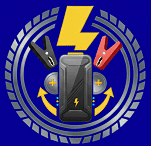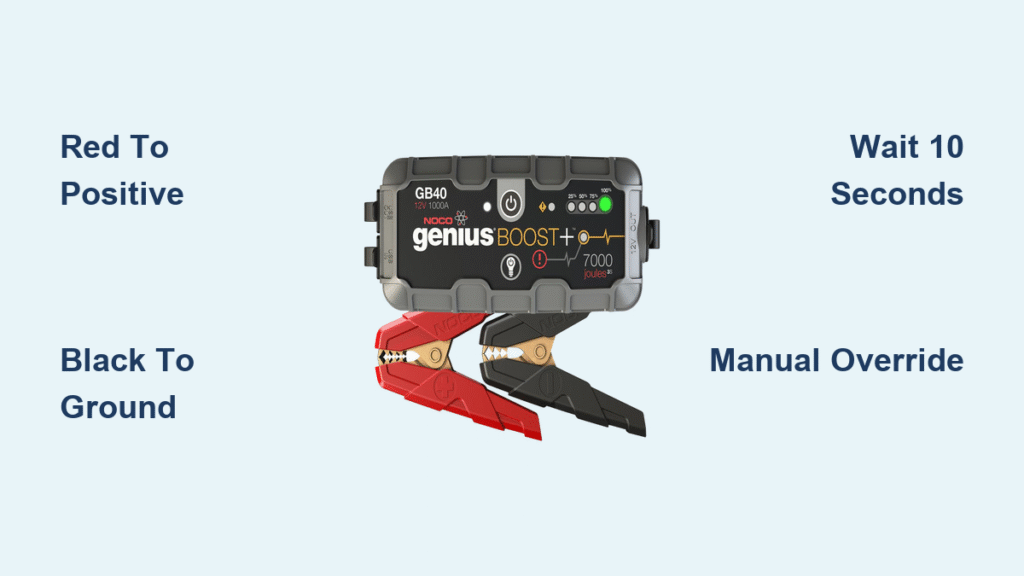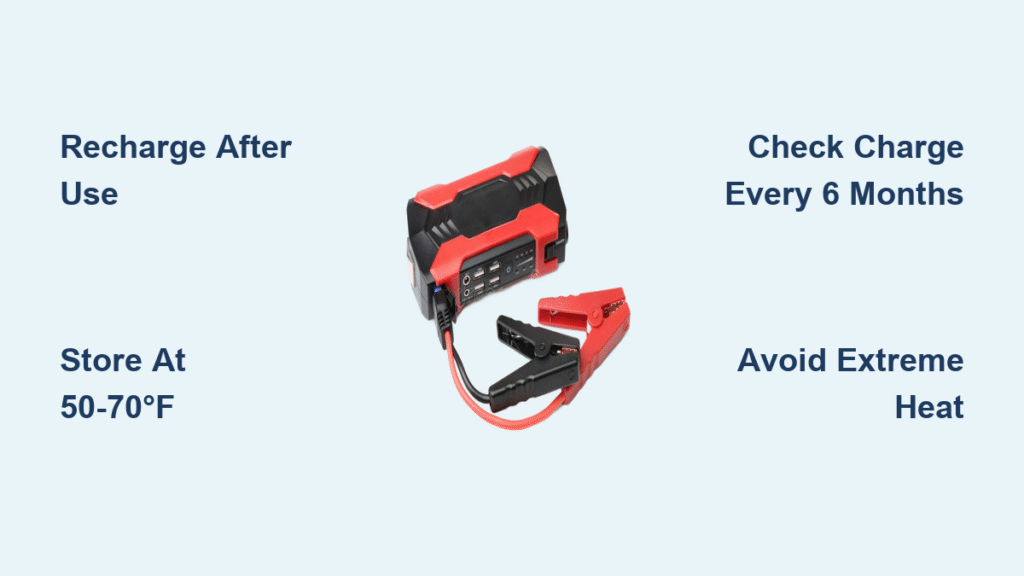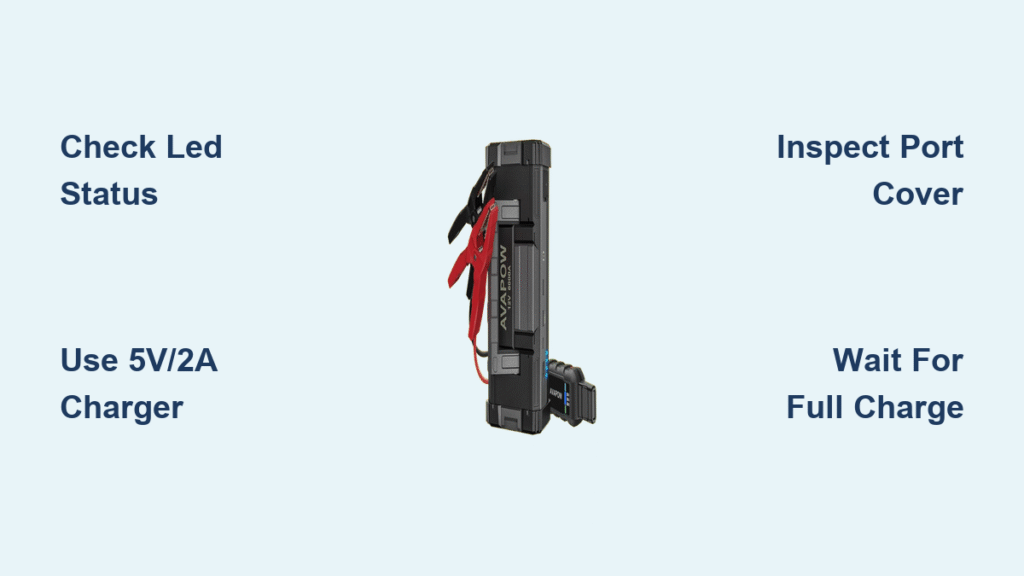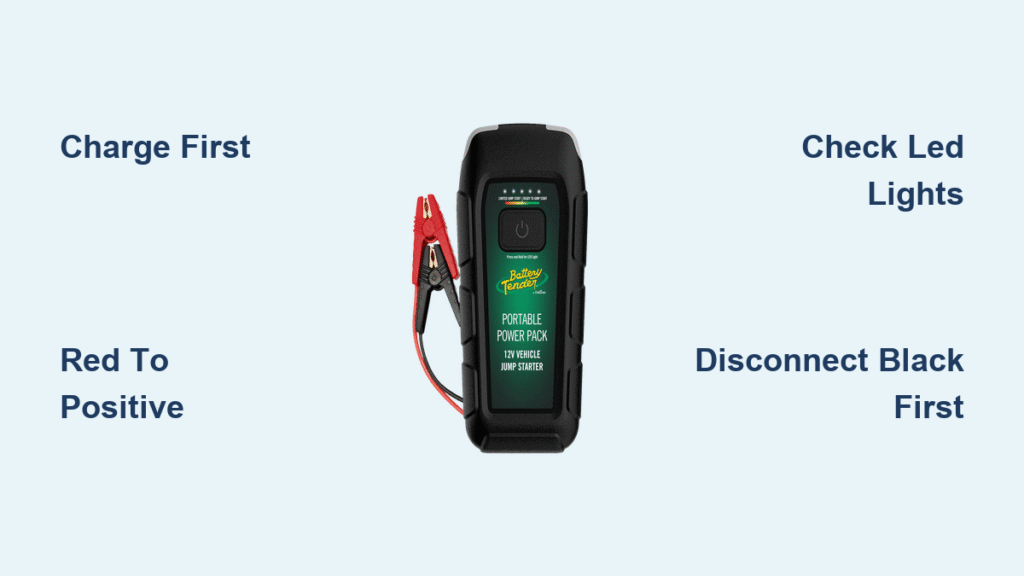Stranded at midnight with a dead battery as rain starts pouring? Your NOCO Boost GB40 sits in the trunk—a pocket-sized lithium powerhouse delivering 1,000 amps of jump-starting muscle—but you’re fumbling with clamps while traffic speeds past. Most owners never unlock its full potential, wasting money on roadside assistance when this $100 device could save the day. This guide cuts through the confusion with battle-tested procedures straight from the manual, transforming your GB40 from a basic jump starter into a complete roadside rescue system. Master these steps and never get stranded again.
Correct Clamp Attachment for Instant Power Transfer

Skip this critical step and your jump-start fails before it begins. Your GB40’s spark-proof technology only works when connections are perfect.
Red Clamp: Positive Terminal Precision
Attach the red clamp only to the battery’s exposed positive terminal (+). Never connect to corroded surfaces or cable covers—scrape clean metal if needed. A weak connection here means insufficient amperage to crank the engine.
Black Clamp: Grounding Secrets Mechanics Know
The black clamp must grip unpainted metal on the engine block or frame—not the negative battery terminal. Ideal spots include:
– Alternator mounting bolts
– Intake manifold brackets
– Engine lift hooks
This bypasses potential ground path issues in the chassis wiring.
Pro Tip: If your car has an exposed metal strut tower near the battery, that’s the best grounding point—shortest path to engine mass.
Power Sequence That Prevents Costly Mistakes
Pressing the wrong button first triggers safety locks. Follow this exact order every time:
Why Single Press Beats Holding the Button
A single tap on the Power Button activates the GB40’s safety systems. Holding it longer does nothing—NOCO intentionally designed it this way to prevent accidental discharge. Watch for the solid white Power LED: no light means either dead GB40 battery or faulty clamp contact.
Critical 10-Second Waiting Rule
After connecting clamps and powering on, wait 10 full seconds before cranking. This lets the GB40’s circuitry:
1. Verify correct polarity
2. Measure battery voltage
3. Activate thermal protection
Skipping this risks thermal shutdown mid-crank.
Manual Override: Rescuing Truly Dead Batteries
When your car shows zero signs of life—not even dashboard lights—you’ve got a sub-2-volt battery. Standard mode fails here, but Manual Override saves the day.
How to Spot a Sub-2V Battery Emergency
Your dead battery needs this mode if:
– Headlights won’t glow dimly
– Ignition makes no clicking sound
– Multimeter reads below 2.0V
The GB40’s Boost LED stays dark—this is your signal to override.
Step-by-Step Forced Jump Start
- Double-check clamp connections (red to +, black to ground)
- Press and hold Manual Override button for 3 full seconds
- Watch for flashing white Boost LED (confirms override active)
- Crank immediately—do not wait—as safety systems are disabled
⚠️ Life-Saving Warning: Manual Override removes all spark protection. Ensure clamps never touch each other during connection. If you smell burning plastic, disconnect instantly.
Decode GB40 LED Signals in Under 5 Seconds

That blinking light isn’t random—it’s speaking a precise diagnostic language. Learn these patterns to troubleshoot faster than a mechanic.
Emergency Error Flashing Translations
| LED Pattern | What It Means | Your Immediate Action |
|---|---|---|
| Solid red Error LED | Reverse polarity | Swap clamps NOW—red to +, black to ground |
| Blinking red Error LED | Overheating | Move GB40 to shaded area—wait 7 minutes |
| Flashing white Boost LED | Manual Override active | Start engine within 30 seconds or reset |
Battery Level Survival Guide
Don’t get stranded mid-rescue:
– 1 bar showing: Enough for one jump—recharge immediately after
– 2 bars: Safe for 2-3 jumps (ideal emergency reserve)
– 0 bars: Unit appears dead—plug into wall charger before next use
Flashlight Modes That Save Lives Off-Road
Your GB40’s light isn’t just for changing tires—it’s a critical safety tool most owners ignore.
SOS Mode Activation Shortcut
Press the Light Mode button four times rapidly to jump straight to SOS distress signal. This international standard flashes:
– 3 short pulses (dots)
– 3 long pulses (dashes)
– 3 short pulses (dots)
Works even with dead internal battery if vehicle is running.
Night Vision Preservation Trick
For camping or roadside repairs, use 10% brightness mode (third press of Light Mode button). This preserves your night vision while illuminating work areas—critical when changing tires on dark highways.
Troubleshooting That Fixes 95% of Failures

When your GB40 “doesn’t work,” these three checks solve most issues before you panic.
No LED Response? Check This First
- GB40 battery level: Plug into wall charger for 2 minutes—even “dead” units often revive
- Clamp teeth condition: Worn teeth won’t bite through corrosion (replace with GBC003 Precision Clamps)
- Ground point conductivity: Scrape paint off engine block with a pocket knife
Overheating Fix for Summer Emergencies
If blinking red Error LED appears in hot weather:
– Place GB40 on concrete pavement (cools 2x faster than car interior)
– Cover with reflective emergency blanket (lowers temp by 30°F)
– Wait exactly 5 minutes—thermal sensors reset faster than manual states
USB Power Bank Hacks Mechanics Swear By
Your GB40 isn’t just for jump-starts—it’s a lifeline when your phone dies during breakdowns.
Priority Charging During Emergencies
The GB40 automatically:
1. Pauses USB charging when jump-starting
2. Resumes USB output 15 seconds after engine starts
3. Delivers 2.1A fast charging to dead phones
Pro Tip: Plug your phone in before starting the car—this prevents power surges from damaging devices.
Essential Accessories That Prevent Disaster
Skip these and risk failure when it matters most.
Permanent Installation Kit (GBC007)
$24.95 for M8 eyelet terminals that:
– Bolt directly to battery posts
– Survive extreme temperatures (-40°F to 185°F)
– Let you attach GB40 in 8 seconds without opening hood
Heavy-Duty Clamps (GBC003)
Standard clamps fail after 20 jumps. These professional-grade replacements:
– Handle 1,200 amps (20% over GB40’s rating)
– Feature corrosion-resistant copper teeth
– Cost less than one tow truck call
Storage Secrets That Double Battery Life
NOCO’s 3-year warranty assumes proper care—follow these to hit 5+ years.
The 50% Charge Sweet Spot
Store your GB40 at exactly 50% charge (2 white bars showing). Lithium-ion batteries degrade fastest at 0% or 100%. Recharge every 4 months—set phone reminders labeled “GB40 Check.”
Winter Survival Protocol
Below 32°F:
1. Keep GB40 in heated cabin overnight before use
2. Warm unit with hand warmers for 10 minutes
3. Never attempt jump-starts below -4°F—lithium freezes solid
Safety Checklist Before Every Jump
One skipped step risks battery explosion. Verify these every time:
The 30-Second Pre-Jump Inspection
- Glasses on: Battery acid causes blindness (keep spares in glovebox)
- Ventilation check: Work in open area—hydrogen gas ignites easily
- Clamp gap: Maintain 6+ inches between metal ends until connected
Manual Override Emergency Protocol
When using forced mode:
– Remove all metal jewelry (watches, rings)
– Stand clear of battery during crank
– Have Class ABC fire extinguisher within arm’s reach
Key Takeaways for Roadside Confidence: Your NOCO Boost GB40 solves 99% of dead battery emergencies when you master three non-negotiables: perfect clamp placement, LED language decoding, and Manual Override protocols. Store it at 50% charge, replace standard clamps with GBC003 upgrades, and always verify ground connections on bare engine metal. Within 90 seconds of connecting, you’ll hear that sweet engine roar—no tow trucks, no waiting, just pure mechanical triumph. Keep this guide taped inside your glovebox, and the next time your battery dies, you won’t just restart your car… you’ll restart your confidence.
